Vol 4 No. 26 TROPIC LIGHTNING NEWS June 30, 1969
Index
Joint Effort Smashes NVA
The NVA opened a drive for Tay Ninh City on June 18 and 19.
In an apparant attempt to take the provincial capital and ancient commercial
center, the communists initiated several intense military flare-ups.
An attack on Fire Support Base Washington was launched against the
3d Battalion, 22d Infantry and 1st Battalion, 27th Artillery, while a
three-pronged attack to the south engaged elements of the 4th Battalion, 23d
Infantry; 4th Battalion, 9th Infantry; and 3d Squadron, 4th Cavalry.
Lightning forces surrounding Tay Ninh were ready.
Washington’s defenders shrugged off all attacks, and the menace south of Tay
Ninh turned into a rout of the befuddled NVA.
 Regulars
Regulars
By SP4 K.C. Cullen
FSB WASHINGTON - For the fourth time in less than three weeks, a 3d
Battalion, 22d Infantry fire support base was subjected to intense shelling
followed by a ground attack. On Thursday night, June 19, at Fire Support
Base Washington, two and one half miles north of Tay Ninh City, early warning
devices began to mark sappers as they crept toward the wire just before
midnight.
Within minutes, flares illuminated the flat marshland surrounding
Washington, clearly defining several sapper squads attempting to make their way
to the fire support base’s perimeter.
“Then,” said Private First Class Randolph Brogan of
Poughkeepsie, N.Y., a medic with the Regulars’ Alpha Company, “they started
pounding us with mortars. I’d never seen so much stuff. There must
have been 200 rounds coming at us. I was hit by some frag from one of them
but not seriously. It took 25 minutes for me to get dusted off because
there were so many mortar rounds still coming in.”
AS THE MORTARS poured in, Major William C. McNamara, Tactical
Operations Commander of Washington, from Clarksville, Ind., and Battalion
Commander Lieutenant Colonel Robert B. Carmichael of Columbus, Ga., (Continued On Page 4&5)
 Manchus
Manchus
By PFC Richard Sears
STRAIGHT EDGE WOODS - One prong of the June 19 NVA offensive broke
against the 4th Battalion, 9th Infantry Manchus, who stormed into a hot landing
zone 10 miles southwest of Tay Ninh City. Along with ARVN Marines, the
Charlie Company Manchus killed 87 dug-in enemy soldiers.
The NVA were in fortified positions with thick overhead cover in
the Straight Edge Woods, an area from which the enemy has often built up and
launched his forces in the past.
The Manchus ran into heavy hostile fire and backed off slightly to
call in air strikes. After airborne ordnance had blasted the hostile
landscape, (Continued On Page 4&5)
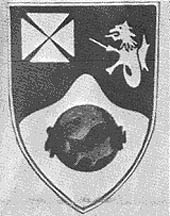 Tomahawks
Tomahawks
By SGT Roger Welt
TAY NINH - Tropic Lightning soldiers of the 4th Battalion
(Mechanized), 23d Infantry Tomahawks and members of the 6th ARVN airborne killed
64 NVA soldiers on the edge of Tay Ninh City June 19.
Preventing the enemy from reaching the famous Cao Dai Temple, the
Tomahawks sealed off all avenues of approach with armored personnel carriers.
The combination of Tomahawks and ARVN forces pushed the enemy back
to an area where Cobra gunships could be called in.
Said Lieutenant Colonel G. E. Taylor, Shelby, N.C.: “The gunships
did a beautiful job. They destroyed a mortar position and (Continued
On Page 4&5)
 Raiders
Raiders
By PFC Victor K. Allison
FSB HAMPTON - An attempted ambush of a 3d Squadron, 4th Cavalry
convoy brought the Raiders into action against an element of the 271st NVA
Regiment four miles south of Tay Ninh; 98 enemy were killed.
When the convoy was hit, Charlie Troop sent its 2d and 3d platoons
to the assistance of the vehicles, leaving the 1st Platoon to guard the night
defensive position.
OPENING THE affair by firing an RPG in the track of the lead
armored personnel carrier, the enemy showered the Cav with automatic weapons’
fire and RPG rounds.
Attacking the U-shaped ambush, the Cav found the ambush closed
behind and had to fight its way back out, literally backing over the NVA - the
11th Gold Star Regiment is about 30 per cent female - on the way.
After the 1st platoon was brought up, the damaged vehicles were
sent back to Fire Support Base Hampton with the convoy, using the 3d platoon for
an escort.
BACK TO THE assault went the 1st and 2d platoons. They backed off
slightly, called in artillery, and charged in again. In this assault the
command track was hit, killing the commander of Charlie Troop and wounding his
second in command. Specialist 4 Fred Ogas of El Paso, Tex., found himself
in command, and he maneuvered the troop for the rest of the day.
Meanwhile Bravo Troop was moving to the sound of the guns to aid
Charlie Troop. Eventually both troops fell back into a night defensive
position. One Sheridan of its 1st platoon was hit by seven RPGs but was
still providing flank security.
 |
SERGEANT FIRST CLASS Donald Neal of Columbus, Ga., checks out a wounded NVA soldier for concealed weapons outside FSB Washington. (PHOTO BY SP4 K.C. CULLEN) |
| SAFETY Undoubtedly the best safety advice the TLN could pass along this week would be to warn NVA to stay well away from Tay Ninh City. But for GIs we’ll just give the word that maintenance on the M-16 is a good way to keep the NVA a safe distance from you. |
Page 2 TROPIC LIGHTNING NEWS June 30, 1969
Decorated
| BRONZE STAR MEDAL
(HEROISM) |
|
| LTC William R. Strong,
HHC, 25th S&T Bn MAJ Edmond R. York, HHC, 25th S&T Bn MAJ Billy W. May, HHC, 2d Bn, 12th Inf 1LT George Stemmons, Co D, 2d Bn, 22d Inf 1LT Roland J. White, Co B, 3d Bn, 22d Inf 1LT Lodwich K. Alford, C Trp, 3d Sqdn, 4th Cav 1SG A.J. Nichols, Co D, 2d Bn, 12th Inf PSG Theodore Wise, HHC, 4th Bn, 23d Inf PSG Roger E. Mace, HHC, 1st Bn, 5th Inf SSG James H. Shope, HHC 4th Bn, 23d Inf SSG Glenn D. Totten, Co A, 2d Bn, 22d Inf SSG Clyde Briscoe, HHC 2d Bn, 22d Inf SSG Lealon E. Harris, Co A, 65th Engr Bn SGT Audry L. Crumb, Co B, 2d Bn, 22d Inf SGT John P. Lachman, Co B, 2d Bn, 22d Inf SGT Donald H. McMains, Co B, 2d Bn, 22d Inf SGT Jerry D. Irvin, Co B, 2d Bn, 22d Inf SGT Daniel L. Kneale, Co A, 1st Bn, 5th Inf SGT Robin E. Still, Co B, 2d Bn, 22d Inf SGT Richard D. Jobe, C Trp, 3d Sqdn, 4th Cav SGT Aldino P. Coatti, Co D, 2d Bn, 12th Inf SP4 Harry D. Gwynn; Co C, 2d Bn, 22d Inf SP4 Thomas E. Harris, Co C, 2d Bn, 22d Inf SP4 William R. Deckard, Co B, 2d Bn, 22d Inf SP4 Jose A. Perez, HHC, 1st Bn, 5th Inf SP4 Donald J. Smith, Co C, 2d Bn, 22d Inf SP4 Harold Martin, Co C, 2d Bn, 22d Inf SP4 James C. Roberts, HHC, 1st Bn, 5th Inf SP4 Carlyn L. Warriner, Co C, 2d Bn, 22d Inf SP4 Neil T. Buff, Co B, 2d Bn, 22d Inf SP4 James W. Lessard, HHC, 65th Engr Bn |
SP4 Gerald Cedillo, HHC, 2d Bn, 34th Armor SP4 William E. David, Co C, lst Bn, 5th Inf SP4 Daniel D. Ostrowski, Co C, 1st Bn, 5th Inf SP4 Gary A. Steger, Co A, 1st Bn, 5th Inf SP4 Michael F. Koegel, C Trp, 3d Sqdn, 4th Cav SP4 Henry Jerome, Co A, 1st Bn, 5th Inf SP4 Charles L. Brenzikofer, Co C, 65th Engr Bn SP4 James H. Tucker, Co C, 2d Bn, 22d Inf SP4 William E. Turner, Co C, 2d Bn, 22d Inf SP4 John G. Wackeen, Co C, 2d Bn, 22d Inf SP4 Steven West, C Trp, 3d Sqdn, 4th Cav SP4 James B. Buchan, C Trp, 3d Sqdn, 4th Cav SP4 Kenneth R. Parker, HHC, 1st Bn, 5th Inf SP4 Billy D. Miller, C Trp, 3d Sqdn, 4th Cav SP4 Arthur B. Lance, Co C, 2d Bn, 22d Inf SP4 Richard E. Castle, HHC, 4th Bn, 23d Inf PFC Thomas D. Lemke, HHC, 3d Bn, 22d Inf PFC Kenneth G. Green, Co D, 2d Bn, 12th Inf PFC Thomas A. Dudek, Co B, 2d Bn, 22d Inf PFC Kenneth E. Cash, Co C, 2d Bn, 22d Inf PFC Robert L. Montgomery, HHC, 4th Bn, 23d Inf PFC Anthony M. Pantona, Co C, 4th Bn, 23d Inf PFC John E. Griffin, Co B, 2d Bn, 22d Inf PFC Charles Laux, HHC, 2d Bn, 22d Inf PFC Lowell K. Lawson, Co C, 1st Bn, 5th Inf PFC James S. Hubler, Co C, 1st Bn, 5th Inf PFC Donald R. Williams, Co E, 4th Bn, 23d Inf PFC Thomas Langenburg, Co C, 1st Bn, 5th Inf PFC Ernest J. Salas, Co C, 2d Bn, 22d Inf PFC Timothy E. Poth, Co D, 2d Bn, 12th Inf PFC Keith D. Bell, Co C, 1st Bn, 5th Inf |
You Can Save Your Money
One of the unpleasant side effects of the war that fall almost
exclusively on the Vietnamese is the inflation touched off by the presence of
half a million freespending American troops.
Since 1966 enough extra money has found its way into the local
economy through Saigon tea, porcelain elephants, short-timer sticks and the like
to push the price of rice up more than 200 per cent. Chicken is up 147 per
cent, and the all-important nuoc nam is up almost 300 per cent.
FREE SPENDING on the local economy hurts countless people, and you
have beaucoup better things to do with your money. The army offers you no
less than four ways to save and manage your money and provides the PX system to
supply genuine, once in a lifetime bargains.
The Uniformed Services Savings Deposit Program, for one, is perhaps
the best savings program in the world, and it is available only to U.S.
servicemen overseas. A class S allotment or a cash deposit at the finance
office is all that’s needed to take advantage of the 10 per cent interest rate
compounded quarterly. Money cannot be withdrawn while you are overseas
except in an emergency, but you can arrange to leave it in an extra 90 days
after you DEROS to take advantage of an extra dividend.
Savings Bonds, purchased regularly through an allotment, represent
an investment impossible to beat. The interest has been upped to 4.25 per
cent, and a savings bond program allows you to buy Freedom Shares, treasury
notes which pay a high five per cent and mature in only four years from the date
of purchase.
Nowhere in the States can you open a checking account that will pay
interest on its balance. With the in-country banking facilities, the
government has arranged for servicemen to be able to open checking accounts with
no service charges or charge for personalized checks. Accounts with a
balance of more than $100 earn 5 per cent interest. You can still have
cash. when and where you need it and keep the advantages of a savings account.
IF YOU WANT to continue to make regular payments to your bank
account back in the world or have your payments on an insurance policy,
automobile or home automatically taken care of, the Army Finance center will
mail the checks for you monthly. All you have to do is arrange for the
proper class E Allotments with the finance office.
With all that money you’ve saved, genuinely worthwhile purchases
can be made in the PX or through the PX’s mail order service, which offers low
prices on many Asian-manufactured products. Radios, TVs, cameras, watches
and audio equipment are offered for sale at prices far below Stateside.
You can even have a discount priced new car of your choice waiting
for you when you return home.
Your memories of Vietnam can include a new car, a stereo tape
system, a camera and a solid bank account, items of some lasting function or
enjoyment. Or you can treasure as best you can a few evenings of wining,
wenching and wassailing with the Saigon tea set.
TROPIC LIGHTNING
Combat Honor Roll
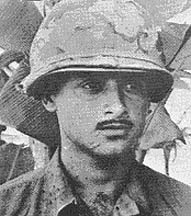 Added to the Tropic Lightning Combat Honor Roll this week is
Specialist 4 George E. Chavez of Company C, 1st Battalion (Mechanized), 5th
Infantry. Specialist Chavez was awarded the Silver Star for distinguishing
himself by heroic actions while serving as a squad leader on a sweep operation.
Added to the Tropic Lightning Combat Honor Roll this week is
Specialist 4 George E. Chavez of Company C, 1st Battalion (Mechanized), 5th
Infantry. Specialist Chavez was awarded the Silver Star for distinguishing
himself by heroic actions while serving as a squad leader on a sweep operation.
When Company C came under hostile fire from a hedgerow, Chavez’s
armored personnel carrier sustained a direct hit from a rocket propelled
grenade. Knocked from the vehicle, Chavez immediately recovered and
carried two wounded men to safety.
Chavez and his driver then returned through intense hostile fire to
the vehicle, 50 meters in front of friendly elements, and fought off aggressors who
were attempting to man the personnel carrier. Remaining in the advanced
position, Specialist Chavez placed suppressive fire on the insurgents until
reinforcements reached his position.
After Chavez had reorganized his squad, the platoon leader was
seriously wounded in a second assault. Chavez immediately took command of
the element and continued the mission. During the final assault, Chavez,
now acting as platoon sergeant, killed at least three enemy soldiers with small
arms fire and hand grenades.
Tropic Lightning Tots
The Commanding General Welcomes
The Following Tropic Lightning Tots
To The 25th Infantry Division – As
Reported By The American Red Cross.
Born To:
| June 2 PFC William L. Finfrock, HHC, 1st Bn (Meth), 5th Inf June 5 SP4 Dennis Peton, C Btry, 1st Bn, 8th Arty, a daughter SP4 Richard E. Murphy, HQ & Co A, 725th Mnt Bn, a girl June 3 SP5 James A. Smith, C Co, 2d Bn, 14th Inf, a boy SP5 Marshall W. Mullings, HHD, 125th Sign Bn, a daughter June 6 CPT Thomas S. Hyun, HHC, 2d Bn, 27th Inf, a daughter MSG Cepha Drummond, HHD, 125th Sig Bn, twins, a daughter and a son June 7 CPT. Larry L. Wallace, HHB, 3d Bn, 13th Arty, a daughter 1LT Joseph J. Terwey, HHC Band DISCOM, a son 1LT Robert Shultz, HHC, 25th Infantry Division, a daughter SSG Tommy Brewington, A Trp, 3d Sqdn, 4th Cav, a daughter SGT Joseph H. Wasburn, Trp A, 3d Sqdn, 4th Cav, a daughter PFC John T. Lucero, Co D, 2d Bn, 27th Inf, a daughter |
June 8 SP5 William Burton, 20th Trans Co, a son SP4 Thomas Pavlogack, 25th MP Co, a daughter June 9 PFC Gerald L. Lagalo, Co A, 554th Engr, a son June 10 SP4 James J. Staab, Co D, 2d Bn, 14th Inf, a son June 12 SGT Lyle McClung, B Trp, 3d Sqdn, 4th Cav, a son SP4 Paul G. Erno, Co B, 25th S&T Bn, a son SP4 Russell J. Donahue, HHC, 2d Bn, 12th Inf, a daughter PVT Larry E. Beisley, Co A, 2d Bn, 27th Inf, a son June 13 SSG Richard Mitchell, Co B, 25th Avn Bn, a son SP4 Dale E. Grate, HHB, l st Bn, 8th Arty, a son June 14 1LT James E. McKinley, Co C, 1st Bn (Meth), 5th Inf, a son |
The TROPIC LIGHTNING NEWS is an authorized publication of the 25th Infantry Division. It is published weekly for all division units in the Republic of Vietnam by the Information Office, 25th Infantry Division, APO San Francisco 96225. Army News Features, Army Photo Features, Armed Forces Press Service and Armed Forces News Bureau material are used. Views and opinions expressed are not necessarily those of the Department of the Army. Printed in Tokyo, Japan, by Pacific Stars and Stripes.
MG Ellis W. Williamson . . . . Commanding General
MAJ John C. Fairbank . . . . . Information Officer
1LT John C. Burns . . . . . . . . Officer-in-Charge
SP4 Robert Imler . . . . . . . . . . Editor
SP5 Charles Withrow . . . . . . Assistant Editor
SP4 Ralph Novak . . . . . . . . . Production Supervisor
BATTALION CORRESPONDENTS
SGT Jan Anderson
PFC Ken Brown
SP4 Arthur Brown
PFC Larry Goodson
SP4 Richard Huhta
PFC Phil Jackson
PFC Craig Sampson1/5
1/8
2/12
2/12
2/14
2/27
2/27SP5 Doug Elliott
PFC Dave Duncan
SP4 Dave DeMauro
PFC Dan Stone
SGT Roger Welt
SP4 Pete Freeman2/34
3/4
3/22
4/9
4/23
7/11
Page 3 TROPIC LIGHTNING NEWS June 30, 1969
Good Grief, It’s Snoopy Again, Back at the Front
By SP5 Larry Hamilton
DAU TIENG - Vatch out Red Baron. Der Beagle ist loose in der
3d Brigade and it vill be der wienersnitchel if you let him get on your tail.
Snoopy, that delightful dog, has said “peanuts” to his Sopwith
Camel, silk scarf and leather flying helmet and has matured with the air age.
Imagine a conversation like this: “This is the Army flying ace
piloting his light observation helicopter over enemy territory in the
Trapezoid.”
THAT’S RIGHT, Snoopy’s a chopper man now.
“The pooch has been putting in so many air hours lately, that
we’ve had to take him off the flight line,” said First Lieutenant H.C.
Thorpe of Hugo, Okla., the 3d Brigade’s “Snoopy” aviation operations
officer.
But the ace’s tradition is carried on by pilots Captain L.E.
Campbell of Muskogee, Okla.; First Lieutenant William Lang of San Francisco; and
Warrant Officers George Rehmus of Madison, Ill. and Vardaman Smith of Virginia Beach, Va.
“With the dog’s LOH off the line now, we have four OH6A Cayuse
helicopters in the section,” said Thorpe. “We’re seriously thinking
about making Snoopy’s into a dog house.”
THE FOUR LOHS fly a number of different missions for the brigade,
but the two most important are courier missions and command and control flights
for battalion commanders. However, the aviation section has participated
in a number of medevac operations.
“We’ve flown into hostile territory to evacuate wounded GIs,
wounded Vietnamese soldiers and even a few wounded enemy. Once, we
evacuated two wounded Vietnamese children who had tripped an enemy booby
trap,” said Thorpe.
One of the advantages the Cayuse has over the Sopwith Camel is its
ability to set down in treacherous terrain.
“In many cases, we can land in the smallest of places - places
where a Huey (or a Sopwith Camel) wouldn’t even attempt,” said Thorpe.
He learned of the Cayuse’s super-maneuverability recently when he performed
the daring rescue of a 3d Brigade forward air controller who had parachuted into
the dense jungle around Dau Tieng.
“No other aircraft could have gotten into the tiny area that my
Cayuse did. It’s a fine craft for just about any type of flying
mission,” he said.
MANY TIMES, “Snoopy” aviation acts as emergency resupply for
line troopers. Warrant Officer George Rehmus flew a resupply mission
recently - one that didn’t really fit into the emergency category.
“Wolfhound and Triple Deuce infantrymen were in contact with a
large enemy force in the Trapezoid, and the Wolfhounds’ commander, Lieutenant
Colonel James T. Bradley, thought the troops would appreciate a little
‘luxury’ out there. He got together about 20 cases of soft drinks and
gallons and gallons of ice cream and I dropped them off while the troops broke
for lunch. The area I landed in wasn’t exactly an asphalt runway, but
the landing was worth it just to see some smiles on faces,” he said.
But what about der Red Baron?
“Oh, we don’t worry about him much anymore - the dog’s got
him fairly well ‘psyched out,’” said First Lieutenant William Lang, the
section’s safety officer.
“BESIDES, THE Cayuse is equipped with a lot of safety features,
like collapsible seats, shock absorbing struts, a roll bar and an all-plexiglass
bubble, that can take a lot of punishment - maybe even a dogfight with an
Albatross, the Baron’s favorite,” he said.
Are the pilots kept busy? Yes, they certainly are with
flying, maintenance and all the other duties associated with combat support.
“But, if things get too hectic,” said Thorpe, “we can always
put Snoopy back on the flight line. That is, if he ever gets back from his
R&R at the Daisy Hill Puppy Farm.”
 |
GENTLY - You can’t rush while looking for boobytraps in the underbrush. Specialist 4 Don Peters of Cold Springs, Minn., cautiously checks heavy foliage on a sweep near Fire Support Base Keene. (PHOTO BY SP4 RICHARD HUHTA) |
‘Hawks Fly For Once
TAY NINH - The men of Charlie Company, 4th Battalion
(Mechanized), 23rd Infantry had a full day recently when they air-assaulted into the
Crescent area, 13 miles east of Tay Ninh City.
An air assault might not be unusual to a lot of infantrymen, but
the Tomahawks are a mechanized unit. Questions like, “How do our APCs
get out there and what are they going to use for helicopters - Chinooks?” were
asked the night before. Needless to say the APCs stayed behind.
As the Tomahawks and their counterparts from the Army of the
Republic of Vietnam approached the landing zone, a startled NVA soldier was
caught off guard in the open. “The enemy soldier did not know what to
do, he was so surprised to see the choppers,” said Specialist 4 Paul Boult of
Arlington Heights, Ill.
“One of the ARVN soldiers shot him as he ran around on the ground
in complete confusion,” said Boult.
 |
CHAT - Specialist 4 Larry Haney, left, of Tahlequah, Okla., and First Lieutenant H.C. Thorpe of Hugo, Okla., finish up their preflight check before Thorpe, the 3d Brigade’s aviation operations officer, takes off on a combat su pport mission. (PHOTO BY SP5 LARRY HAMILTON) |
Girls Walk Point for Warriors
By SP4 Art Brown
CU CHI - Two Vietnamese girls and a quick-thinking Kit Carson Scout
turned what could have been a nightmare for infantrymen of Alpha Company, 2d
Battalion, 12th Infantry into a safe but still nerve-wracking sweep operation
recently.
Action began when a booby-trapped Chicom grenade was tripped in an
area three miles northwest of Trang Bang. The grenade failed to detonate.
TWO VIETNAMESE girls nearby were asked to assist the unit by the
platoon’s Kit Carson scout, a former Viet Cong who had rallied to the
government of the Republic of Vietnam.
The girls were questioned by the scout, who relayed the
information, in broken English, to platoon leader First Lieutenant Patrick
Kiggins of Willingboro, N.J. According to the girls, few Viet Cong or
North Vietnamese soldiers were in the area. But the girls had seen a
couple of men setting booby traps.
The girls volunteered to walk “point” - one for each file of
infantrymen - and show the Americans where the booby traps were located.
“THEY TOLD us to walk on the rice paddy dikes,” related
Kiggins,
“which seemed strange to us.”
“We moved out cautiously behind our ‘point girls’ and soon
found out they were telling the truth. They must have pointed out two
dozen booby traps.”
The girls led the way back to the Warriors’ base, where they were
rewarded for their volunteer work. Under the 25th Division’s “VIP”
program they could be paid in piasters for pointing out the booby traps.
Going even further with their help, the girls led the Warriors back
along the trail with demolition men to destroy the booby traps. As the
girls pointed out each of the lethal devices, the engineers blew the traps in
place.
| DUCK - The war came to a screeching halt recently for an armored column of the 4th Battalion (Mechanized), 23d Infantry Tomahawks as two ducks (out of step) were given a chance to scramble out of the right of way. (PHOTO BY SGT ROGER WELT) | 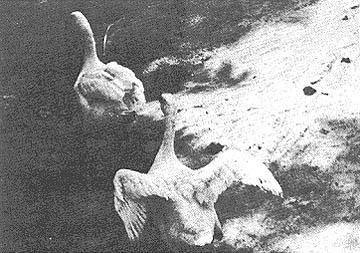 |
Page 4-5 TROPIC LIGHTNING NEWS June 30, 1969
HEAVY FIGHTING SMASHES
THREAT TO TAY NINH
CO Killed, SP4 Honchos Troop of 3/4 Horsemen
Specialist 4 Fred Ogas of El Paso, Texas, took command of Charlie
Troop, 3rd Squadron, 4th Cavalry in action Thursday afternoon, in a tradition as
old as the cavalry itself.
In the midst of an attempted ambush by the D-1 Battalion, Gold Star
Regiment against the Three-Quarter Cavalry Troop, the commanding officer of the
troop was killed and the lieutenant next in command severely wounded.
Ogas, thrown clear of the command track by the explosion, quickly
assessed the situation, scrambled to his feet and by hand signals reorganized
the unit. Specialist Ogas had until that moment been operating as the
command track controller, and as such possessed a clear understanding of the
overall deployment of the troop.
He grabbed the radio and contacted the Squadron Commander, LTC
Robert S. McGowan, who was flying overhead in his C-and-C ship. “He just
reported that he had pulled the troop into formation and was ready for
orders,” said McGowan. “I told him he was doing a fine job and to keep
it up. That was the change of command ceremony.”
 |
GOOD’ JOB -- Major General Ellis W. Williamson, Tropic Lightning CG, congratulates SP4 Fred Ogas, who commanded Charlie Troop, 3d Sqdn, 4th Cavalry for three hours after his commander was killed in action. (PHOTO BY PFC VICTOR ALLISON) |
Enemy Plan Foiled...
Tomahawks
(Continued From Page 1)
got nine more secondary explosions.”
The village never eluded allied control. Sgt. Willie Lee, of
Morris Point, Miss., had nothing but praise for the ARVN forces. “They
came on line and advanced right through the kill zone, eliminating all
resistance,” said Lee.
Along with artillery and gunships the allied forces had support
from the ARVN air force. “Those ARVN pilots are great. They
pinpoint the target, then blow it off the map,” said Specialist 4 Jerome
Trainer, of Birmingham, Ala.
Manchus
(Continued From Page 1)
Charlie Company and the ARVN Marines swept into the woodline.
“We advanced in with our M-16s blazing, throwing grenades into
bunkers, blowing Charlie in place,” said Specialist 4 Dene Morris of Los
Angeles. “I really felt proud of the company.”
After six hours of hard fighting the enemy was driven out into an
open field where the Manchus’ Bravo Company had set up a blocking force.
Caught between two fires, the enemy force, with the choice of running or waiting
to be killed, dissolved.
Major Harry D. Ray, better known to his men as the Mad Manchu,
allowed as how they had turned it into a regular turkey shoot. “The men
kept the pressure on all day,” he added.
The Manchus captured one .51 caliber machinegun and destroyed three
others in their advance through the enemy complex. They also policed up
two Chicom light machineguns, 10 RPG launchers and 40 RPG rounds.
Regulars
(Continued From Page 1)
brought their full firepower assets to bear. As McNamara put it, “We
knew what they were up to. We just wanted to take full advantage of the
open terrain surrounding Washington by using the rapid fire weapons, Spooky and
the gunships while the NVA were without cover and still a great distance from
us.”
Five batteries of artillery, including Washington’s own Charlie
Battery, 1st Battalion, 27th Artillery, and tactical air strikes supported the
ground forces. Spooky and gunships encountered heavy .51 caliber fire, but
the combined air power quickly silenced it. The miniguns and vulcan
cannons of the various aircraft repeatedly hosed down the area with 7.62 and
20mm rounds.
Carmichael and his Command Sergeant Major, Robert G. Adams of
Lexington, Ky., were both wounded from shrapnel during the initial enemy
barrage.
But despite the devastating output of lead from the sky, the
determined enemy moved against the northwest region of the perimeter. The
infantrymen of Alpha, who had been firing steadily while it rained metal, now picked up the tempo of
their firing.
“THE FIRE discipline was fantastic,” said First Lieutenant
Robert Tripp, 2d Platoon Leader, of Raleigh, N.C. “They kept the rate of
fire constant, but when they saw the NVA getting closer they made it a little
more constant. They needed no order to increase but they all knew when to
do it.”
The 2d Platoon bore the ground attack as can be deduced from the
actions of Raymond Hager, a machine-gunner from Ransom, Ky. “After
putting 3,500 rounds through the gun,” he said, “I completely rebuilt the
gun from spare parts I always keep with me. With the help of Tony
(Specialist 4 Antonio Gomez of San Jose, Cal., his assistant gunner), we had the
job done and were firing another 1,500 rounds in about six minutes.”
Hager used a total of three barrels in the course of the night. The NVA
did succeed in blowing a hole in the second strand of wire, but the second
platoon made a wall of lead far more formidable than the wire.
AS DAYLIGHT came, the NVA fled under cover of sporadic sniper fire.
Behind them they left 35 dead and six comrades picked up as detainees, three of
whom were wounded.
Bravo and Delta companies, along with the recon platoon, assisted
Alpha in the sweeping of the area and came up with numerous munitions.
Among them were five 107mm rockets, 13 AK-47 assault rifles, 1 SKS light
machinegun, a Chicom radio and many grenades, RPG rounds, mortar rounds and
miscellaneous personal equipment.
Captain Gray summed up: “It was a costly mistake for the NVA
after their disaster at Crook, and the credit for the victory goes to each and
every man in this fire support base. Each knew his job and did it
perfectly.”
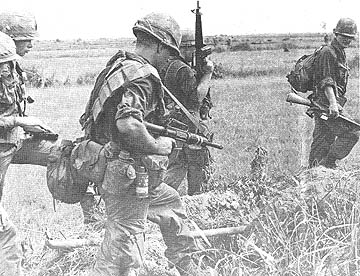 |
CHECK-Captain Larry B. Thomas, Commander of Bravo Company, 3d Battalion, 22d Infantry, of Camp Hill, Pa., warily checks a fighting position which contained a body while sweeping around the perimeter of FSB Washington after a ground attack. (PHOTO BY SP4 K.C. CULLEN)
|
| GRENADIER-A grenadier of Bravo Company, 3d Battalion, 22d Infantry Regulars checks out a bunker while sweeping near FSB Washington. The bunkers, with overhead cover, were built overnight and linked with .51 caliber positions. (PHOTO BY SP4 K.C. CULLEN) | 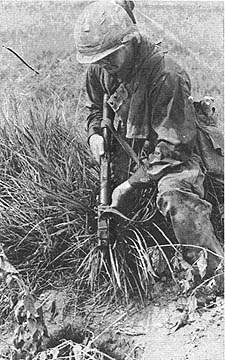 |
 |
(1) Shortly after midnight, Thursday, the 3rd Battalion, 88th Regiment, 9th NVA
Division assaults Fire Support Base Crook. 3rd Battalion, 22nd Infantry
Regulars with the guns of the 1/27 Artillery crush the assault. (2) As the fight at Washington continues, a small force from the 88th Regiment attempts to move toward Tay Ninh where it is trapped, and destroyed by Charlie Company, 4th Battalion 23rd Infantry and elements of the 6th ARVN Airborne. (3) Elements of the 271st NVA Regiment attempt to move north toward Tay Ninh City but are intercepted and driven back by soldiers of the 6th ARVN Airborne Battalion. (4) A second thrust is attempted one mile southeast, where the enemy is routed and a large number of his forces killed by the 4th Battalion, 9th Infantry with elements of the 6th ARVN Recon Co, and the 6th RVN Marines. (5) A Kit Carson scout informs the 3/4 Cav of the position of local VC and NVA forces later identified as Dl, and D14 Battalions. The Cav moves in with the 276th RF Company and routs the enemy forces, cutting deeply into their personnel and equipment. |
Page 6 TROPIC LIGHTNING NEWS June 30, 1969
3d Bde Foils Ambush Try
DAU TIENG - Reacting to intelligence reports, units of the 3d
Brigade pre-empted an enemy convoy ambush attempt, killing 29 North Vietnamese
in eight hours of bitter fighting in a thickly wooded area three miles west of
here.
As infantrymen from the 2d Battalion (Mechanized), 22d Infantry
swept through the area, they spotted two squads of NVA moving into position.
The enemy fired rocket grenades at the armored personnel carriers, then split
into two groups, one withdrawing to the north and the other choosing to fight
from a bunker.
The infantrymen quickly overran the enemy position, killing five
enemy and capturing two weapons and a field telephone.
“Judging from the field telephone, they were probably a wire team
responsible for setting up forward communications,” said Captain Raymond
Kauffman, Charlie Company commander and a native of Lexington, Ky.
The Triple Deuce infantrymen began sweeping the northern position
of the area east to the Saigon River, but no enemy soldiers were found. As
they turned and began sweeping west, they ran into an estimated three squads of
NVA.
“The RPGs were falling like rain from three directions,”
recalled Captain David Crocker of Old Mystic, Conn., Alpha Company commander.
“The enemy soldiers were in the woodlines in bunkers and hiding among fallen
logs in an area recently leveled by rome plows.”
The infantrymen dismounted and stormed the enemy fortified
positions, tossing grenades in the firing ports as they overran each position.
Bravo Company, carrying troopers of Charlie Company, 1st Battalion,
27th Infantry on their tracks, were brought in to hit the enemy on his flanks as
the volume of fire increased.
Artillery batteries from Dau Tieng and neighboring fire support
bases pounded the area with more than 3,000 rounds, while three flights of
F-100s dropped their 500- and 750-pound ordnance on the fortified positions.
During a sweep of the battlefield shortly before darkness, 29 NVA
bodies were found, along with two RPD light machineguns, two AK-47 assault
rifles, one RPG-2 launcher, one 60mm mortar tube, 48 RPG rounds, 129 rounds of
82mm ammunition, 35 rounds of 60mm ammunition, 87 Chicom hand grenades and eight
rifle grenades.
| COOL BREAK from a hot day’s chores may mean simply a can of c-ration fruit cocktail and a shady haystack for Specialist 4 Don Peters of Cold Springs, Minn, a member of the 2/14 Golden Dragons. (PHOTO BY SP4 RICHARD HUHTA) | 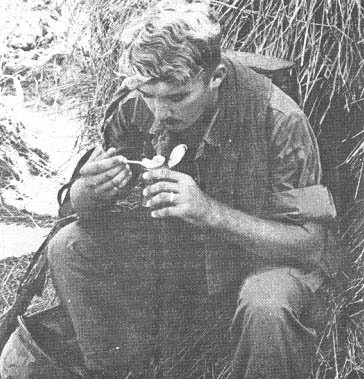 |
Air Cav Mauls Cong
By SP4 John R. Hipes
Early Thursday morning a firefly team from Charlie Troop of the 3d
Sqdn, 17th Air Cav was diverted to support the defense of Fire Support Base
Washington.
In a low sweep around the perimeter the search light ship caught
three sappers in its beam, and a Cobra pounced on them with rockets.
As the search continued more sappers were found, and two were cut
down by the door gunner of the light ship. With the situation still
generally quiet, the Cobras returned to Tay Ninh to rearm.
When they got back to the scene of the action, Washington was under
mortar, rocket and RGP attack.
“We set up our firing pattern,” said First Lieutenant Pat
Harrison, “so that both our machine guns were on the enemy’s stongest point.
With the Cobras covering us, we descended into some pretty vicious .51 and small
arms fire.”
The Cobras followed the slicks in and popped rockets all over the
position. An attempt to blanket the area with mini-gun fire failed when
the guns jammed.
Again the slicks swooped in on the enemy. This time they were
caught in a deadly cross fire and needed immediate help. They got it.
Defenseless and with rockets expended, WOl Thomas More of
Clearwater, Fla., and W01 Mike Earl of Las Vegas, Nev., plunged into the
turmoil.
“I won’t ever forget what they did,” said Harrison. “When we were under the heaviest fire, they flew right down the enemy’s
throat and they didn’t have any weapons. They bluffed the NVA right out
of their pajamas and drew the fire off us.”
Hoi Chanh Leads to Cache
By SP5 Jack R. Anderson
DAU TIENG - A former Viet Cong who rallied to the government of the
Republic of Vietnam made good on his promise recently when he led a 3d Brigade
mechanized infantry company to a large arms store in the upper Boi Loi Woods
near here. He had promised to tell the location of several enemy weapons
caches.
The rallier, who turned himself over to Vietnamese government
authorities in Khiem Hanh District, accompanied Charlie Company, 2d Battalion
(Mechanized), 22d Infantry, on a sweep of a wooded area, pointing out possible
cache sites.
“What we found looked to be a cache site for an ambush
attempt,” said Captain Raymond Kauffman of Lexington, Ky., Charlie Company
commander. “Its location, just off Highway 239, plus its contents, led
us to believe it was placed there for use by an ambush unit.”
The cache contained one SKS carbine, 41 60mm and 82mm mortar fuses,
151 pounds of explosives, 2,000 rounds of AK-47 ammunition, 80 Chicom carbine
rounds, 35 82mm mortar charges, 10 RPG-2 rounds with boosters, four RPG-7 rounds
with boosters, 10 82mm mortar rounds, 30 60mm mortar rounds and 14 57mm
recoilless rifle rounds.
“It was quite a haul,” said Kauffman. “The Hoi Chanh
deserves a lot of credit for taking a chance and telling us where that cache was
located.”
Pad Feeds Cobras
By SP5 Jack R. Anderson
DAU TIENG - Cobra gets its sting from a pad on the north side.
So do Huey and mini-gun LOH.
The sting - an assortment of high explosive rockets and minigun
ammunition. The pad - 25th Supply and Transportation Battalion’s
Rearmament Point on the far northern end of the 3d Brigade’s Dau Tieng base
camp.
THE SUPPLY point rearms Cobra and Huey gunships and minigun-equipped observation helicopters for all units in the brigade’s area
of operation, with the exception of the 1st Cavalry Division, which has a
rearmament point of its own.
“I remember one day we loaded 987 rockets during a contact in the
Michelin Rubber Plantation,” said Specialist 4 Bruce Wetzel of Frederick, Md.,
one of the armorers. “As we broke the packing cases apart, we loaded the
rockets onto the choppers. It was pretty hectic,” he said.
But that was an unusual day for the five men who keep the
rearmament point open 24-hours a day.
“RIGHT NOW, we’re loading an average of about 40 rockets per
day,” Wetzel said. “Of course, when the action picks up for the line
units, it picks up for us too, especially when there’s a lot of air activity
planned,” he added.
The rearmament point sports a selection of four different types of
rockets, plus linked minigun ammunition.
“We have a basic load of 1,500 rounds, which includes the H490
heat round, the H489 air burst and ‘17-pounders’ which are just a bigger
version of the other two,” said Wetzel.
The “rocketeers” on the north side know their job, they’re
well qualified for it. “But,” grinned Wetzel, “it’s still an
explosive situation.”
Eitel Takes Reins Of Triple Deuce
DAU TIENG - Lieutenant Colonel John C.
Eitel, 39, of Newburgh,
N.Y., has taken command of 2nd Battalion (Mech), 22nd Infantry here.
Eitel replaced Lieutenant Colonel Ralph M. Cline, who went to the
United States for reassignment.
“I will do my utmost to live up to your standards,” said Eitel
during a change of command ceremony held at Fire Support Base Wood III, five
miles west of Dau Tieng.
During the period Cline commanded the battalion, the mechanized
infantrymen accounted for more than 530 enemy killed and uncovered numerous
weapons caches.
Page 7 TROPIC LIGHTNING NEWS June 30, 1969
 |
| WINDY OLD WEATHER - Children from the small hamlet of Ap Ninh Hung frolic in the wind created by helicopter blades. The hamlet is near Fire Support Base Rawlins, home of troopers from the 4th Battalion (Mechanized), 23d Infantry. An alert Tomahawk photographer, SGT Roger Welt, caught the action near Tay Ninh City. |
Bravo Deuces Meet, Beat Foe at Rte. 239
By SP5 Jack R. Anderson
DAU TIENG - Mechanized infantrymen of Bravo Company, 2d Battalion
(Mechanized), 22d Infantry successfully defended their night position near here
against an estimated enemy company-sized force, killing eight and detaining
three suspects.
The position, near Highway 239, came under intense RPG, mortar, and
small arms fire in the early hours of the morning.
“THE FIRST thing we did was pull in our listening post - then we
opened up with .50 caliber machinegun fire from the tracks,” said First
Lieutenant Peter Mohan of Butte, Mont., a platoon leader from Bravo Company.
Sergeant Donald Hackett of Seattle, Wash., Bravo Company’s commo
chief, divided his time during the firefight between monitoring his radio and
defending a sector of the perimeter.
“We requested gunships and artillery support right away because,
from the intensity of the fire, we knew the attack was more than just a
probe,” he said. “A low cloud cover made it hard for the gunships to work
effectively and they took a lot of ground fire. But, with their firepower,
plus indirect fire support from three batteries at Fire Support Bases Hunter and
Wood and Dau Tieng base camp, we were able to stop them.”
Later, after the fighting, Lieutenant Colonel John C. Eitel of
Newburgh, N.Y., Triple Deuce commander, commended both gunship and artillery
support for the job they did in preventing more serious injury to the position.
INTENSITY OF the ground fighting was attested to by Mohan, who said
that machinegunners fired about 13,000 rounds of .50 caliber ammunition from
each track.
“When the battle ended, each track had about 2,000 rounds left
over. But that’s one good thing about a mech unit - they certainly have
a lot of firepower.”
“Every time we let up to conserve ammo, the enemy started a heavy
volume of fire again,” said Hackett.
A little after dawn, the fighting ceased. Infantrymen on
sweep discovered an enemy post in a bomb crater nearby. They also found a
60mm mortar position, a 57mm recoilless rifle position and two large trails that
indicated a company-sized element had passed through the area.
Near the area where they found the dead enemy soldiers they also
discovered three AK-47 rifles, two SKS carbines, 24 AK magazines, 15 RPG rounds,
31 Chicom hand grenades, seven gas masks, five canteens, 150 feet of commo wire,
13 sets of web gear and five rifle grenades.
Bobcats Claim 29 in Bau Soi Battle
By SGT Jan Anderson
CU CHI - Reacting against enemy movement spotted from the air,
Alpha Company, 1st Battalion (Mechanized), 5th Infantry recently moved into Bau
Soi in the enemy-infested Citadel, six and one-half miles northwest of Cu Chi.
During a day of moderate fighting, the Bobcat Company, with a company from the
2d Battalion, 14th Infantry killed 21 Viet Cong in the battle area.
As the unit moved into Bau Soi, troops cautiously checked out
several hootches looking for evidence of Viet Cong activity. After finding
indications that the enemy had fled the area, the Bobcats began a sweep of
hedgerows and overgrown areas in the immediate vicinity.
During the push through the first hedgerow, AK-47 fire cracked and
the mechanized troops immediately began to pump .50 caliber machinegun fire into
the dense underbrush of the hedgerow.
Several RPGs streaked toward the APCs, but missed their mark.
Several 60mm mortars popped into the air, but they too fell short.
Before advancing further, the ground troopers halted while air
strikes pounded spider holes and bunker complexes. Before night fell, Alpha Company
was able to advance through the first hedgerow, discovering the Viet Cong bodies
as they went.
The next morning’s sweep uncovered four more Viet Cong bodies,
three AK-47 rifles, three RPG-7 rounds, six 60mm mortar rounds, and 100 pounds of
Polished rice.
Col. Long Gets RVN Medal
By SP4 Karl Karlgaard
CU CHI - In ceremonies held recently at Bien
Hoa, Lieutenant
General Do Cam Tri, III Corps Commanding General, presented Vietnamese Gallantry
Crosses with Gold Star to Colonel H. S. Long of Gallatin, Mo., commanding
officer of the 2d Brigade, 25th Infantry Division, and Lieutenant Colonel
Vincent J. Oddi of Columbus, Ohio, commanding officer of the 2d Battalion, 27th
Infantry Wolfhounds, also part of the 2d Brigade.
The medals were presented at III Corps Headquarters in a ceremony
attended by Vietnamese and U.S. officers.
The two commanders were cited for their personal bravery and for
their effectiveness in leading elements against the NVA forces during February.
During that time their units inflicted heavy damage on NVA forces.
After presenting the medals, Lieutenant General Tri gave his
personal thanks to Colonel Long and Lieutenant Colonel Oddi for jobs well done.
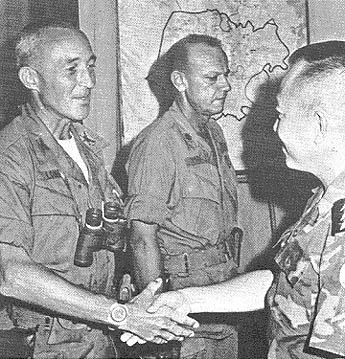 |
LIEUTENANT GENERAL Do Cam Tri congratulates Colonel H. S. Long of Galatin, Mo, and Lieutenant Colonel Vincent J. Oddi of Columbus, Ohio, after presenting the commanders the Vietnamese Cross of Gallantry with Gold Star at III Corps Headquarters at Bien Hoa. (PHOTO BY SP4 KARL KARLGAARD) |
Page 8 TROPIC LIGHTNING NEWS June 30, 1969
Flexible Bde Flattens 56 in Crescent
By SP5 Jack R. Anderson
DAU TIENG - Fifty-Six North Vietnamese soldiers died in two hard
days of battle in the Crescent area west of Dau Tieng with elements of the 3d
Brigade.
A large, black puff erupted in the woodline, and a spinning piece
of shrapnel snapped into a tree behind First Lieutenant Arne Laasko, his
radio-telephone operator and a medic.
“The planes are coming in from the south - because of the sun. I
guess we’d better get down into that bomb crater for a little more cover,”
he said.
Laasko and his platoon from Charlie Company, 1st Battalion, 27th
Infantry Wolfhounds, plus three other infantry companies from the Wolfhounds and
2d Battalion (Mechanized), 22d Infantry were waiting, close to the ground, to
charge the woodline in the jungle area known as the Crescent.
The day before, Bravo Company Wolfhounds and Charlie Company Triple
Deuce had run into stiff opposition from what is estimated to have been an enemy
battalion. Charlie Company Wolfhounds and Bravo Company Triple Deuce were
called in to reinforce the other two companies when they began receiving heavy
mortar fire.
“IT WAS TOUGH going in there for awhile,” said
Laasko,
of Conueaut, Ohio. “We started receiving small arms, automatic weapons,
RPG and machinegun fire about 2:30 p.m. The enemy was entrenched in
well-fortified bunkers, and it was hard to get at him.”
Now the combined four-company force was advancing toward the
contact area again, in hopes of ferreting out any enemy stragglers and
uncovering weapons and food caches.
“We’ve gotten things pretty well under control now,” said
Laasko as he led his men, the lead platoon, into the thickly vegetated woodline.
“There may be a few snipers in here, but I think the main force is destroyed.
I don’t see how anyone could have lived through the series of air strikes and
artillery bombardment our support units have given us.”
A SERIES OF 12 tactical air strikes and more than 3,200 artillery
rounds were spent on the area during the initial contact. One detainee,
taken by Bravo Company Wolfhounds, later told them that precise artillery fire
had routed the enemy unit from his bunkers.
During the second-day sweep, an additional 17 enemy soldiers were
found lying in bunkers where they had died, bringing the total body count for
the two-day operation to 56.
The sweep force also picked up four AK-47 assault rifles, two SKS
carbines, one complete 82mm mortar, one complete 60mm mortar, two machineguns, a
.51 caliber machinegun mounted on wheels, four pounds of documents, eight RPG
rounds, six Chicom hand grenades and an assortment of medical and personal
supplies.
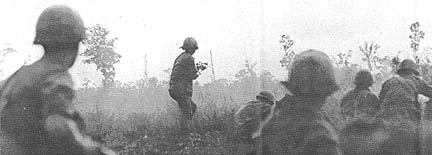 |
|
| THE REAL THING - (Above) An infantryman from battling Bravo
Company, 1st Battalion, 27th Infantry Wolfhounds moves to the fore as he and his
comrades bring maximum fire on an enemy
position in the Crescent. The action, four miles northwest of Dau Tieng,
saw 62 NVA fall to Tropic Lightning might in two days of bitter fighting. (PHOTO BY SP5 JACK R. ANDERSON) FIRST LIEUTENANT Arne Laasko (photo at right) examines part of an enemy uniform found by Charlie Company Wolfhounds near a bunker in the Crescent. Below, Wolfhounds stay low as their position is marked by smoke while an air strike pounds enemy troops in a nearby woodline. (PHOTOS BY SP5 JACK R. ANDERSON) |
 |
 |
Tomahawks Drop 59 NVA in Crescent
TAY NINH - Fifty-nine North Vietnamese soldiers died in a fierce
battle with troops from the 4th Battalion (Mechanized), 23d Infantry, 14 miles
east of Tay Ninh City.
The 4/23 Tomahawks killed 51 enemy in a dramatic late afternoon
battle, and eight more were killed early the next morning.
THE ACTION started when Alpha and Charlie Companies were checking
out a woodline in the enemy-infested Crescent area. Charlie Company had
just found a bunker with 22 RPG rounds in it when nearby North Vietnamese
soldiers opened up.
“As soon as the firing started we received 12 82mm mortar
rounds,” said Specialist 4 Dennis Greeley of Milton, Mass. “We were
so close we heard the mortar rounds leave the tube,” he said. The
Tomahawks maneuvered cautiously through the complex and were soon in control of
the firefight.
While Charlie Company was eliminating the large pocket of
resistance, Alpha Company was fighting through another bunker complex to the
left.
“THE ENEMY hit us with everything he had:
AKs, machineguns, RPGs.
He even had a recoilless rifle in there,” said Private First Class John Eaton
of Lemoyne, Pa., who was wounded by a recoilless rifle.
“We moved from bunker to bunker, destroying each one,” stated
Staff Sergeant John Grosse of Fort Wayne, Ind.
Sergeant Henry Pistilli of Levittown Pa., finally eliminated the
recoilless rifle position. The enemy rifleman was just about ready to pull
the trigger when Pistilli tossed a grenade in his bunker.
After the three-hour battle, the Tropic Lightning soldiers pulled
back to a night laager position. About 4 o’clock in the morning an alert
Tomahawk heard sounds to his immediate front. A flare revealed several NVA
soldiers scurrying for cover.
“WE KILLED eight more enemy soldiers in a matter of seconds,”
said Private First Class Steven Katchen of Budd Lake, N.J. “One enemy
soldier managed to fire one RPG round and that was it.”
“The men have been through a lot these past few days. They
performed in the most professional way,” said First Sergeant Bernard McGuire
of Fort Ord, Cal.
During the fighting the Tomahawks captured one 75mm recoilless
rifle, seven RPG launchers 10 AK-47 assault rifles, 20 AK magazines, 42 Chicom
hand grenades, 75 RPG rounds, and hundreds of rounds of small arms ammunition.
| A HUEY GUNSHIP flies support for the 4th Battalion (Mechanized), 23d Infantry, during operations near the Crescent, 14 miles east of Tay Ninh City. (PHOTO BY SGT ROGER WELT) | 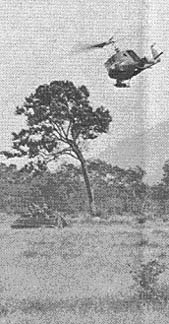 |
Thanks to
Mack D. Gooding, 15th PID, 1st Bde., for sharing this issue,
Kirk Ramsey, 2nd Bn., 14th Inf. for creating this page.
This page last modified 8-12-2004
©2004 25th Infantry Division Association. All rights reserved.